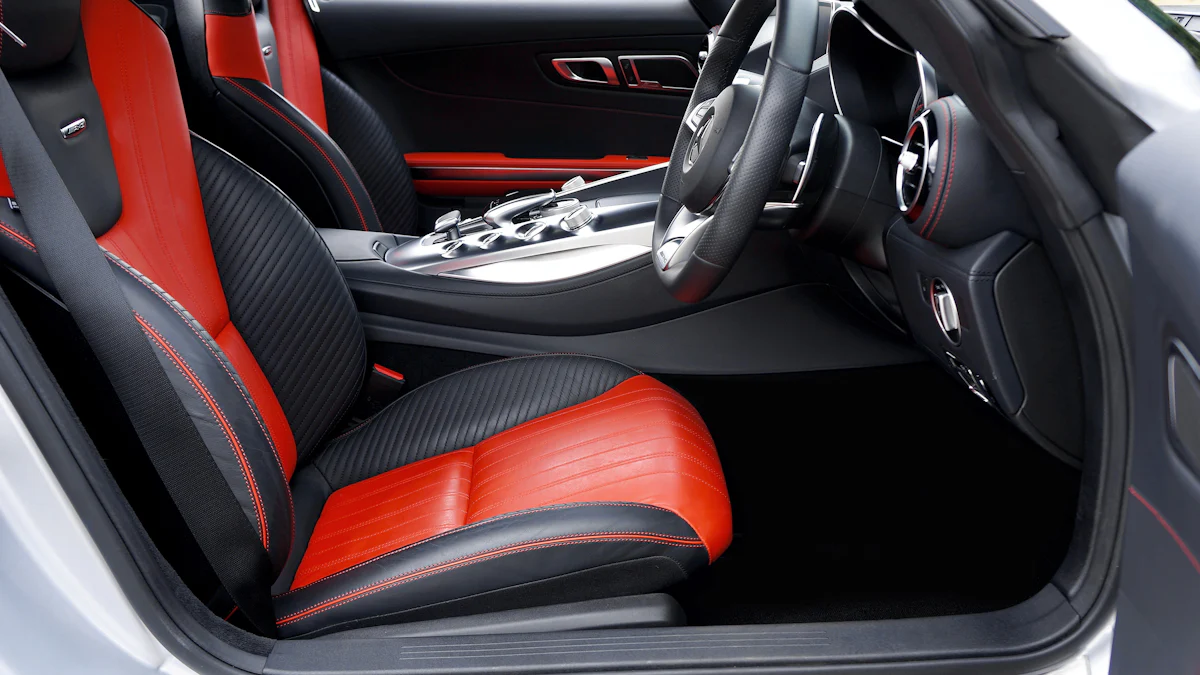如何为汽车打造耐用、时尚的碳纤维车门

Carbon fiber doors offer a remarkable combination of strength, durability, and style. By replacing traditional metal doors, you can achieve significant weight reduction. For instance, a carbon fiber door skin weighs just 4.5 pounds compared to 15.5 pounds for a metal counterpart. This lighter weight enhances vehicle performance and fuel efficiency. Additionally, carbon fiber’s high carbon content, developed since the 1960s, ensures exceptional strength-to-weight ratio and flexibility. Its sleek appearance also adds a modern, stylish touch to your car. With these benefits, crafting your own carbon fiber door becomes an exciting and rewarding project.
主要收获
Carbon fiber doors significantly reduce vehicle weight, enhancing performance and fuel efficiency.
Gather high-quality materials and tools, such as carbon fiber fabric, epoxy resin, and a vacuum bagging system, to ensure a successful build.
Carefully plan and design your door by measuring dimensions and reinforcing critical areas for hinges and handles to maintain durability.
Follow precise steps in the carbon fiber lay-up process, including accurate cutting, resin application, and vacuum bagging, to achieve a strong finish.
Finish your door with sanding, polishing, and applying automotive paint and clear coat for a professional look and added protection.
Ensure proper assembly by securely attaching hardware and aligning the door with your vehicle for optimal functionality.
Experiment with different designs and techniques to personalize your carbon fiber door while enjoying the benefits of its strength and style.
Materials and Tools for Building a Carbon Fiber Door

Creating a durable and stylish carbon fiber door requires the right materials and tools. Each component plays a crucial role in ensuring the final product meets your expectations in terms of strength, weight, and aesthetics. Below is a detailed breakdown of what you’ll need to get started.
基本材料
Carbon fiber fabric (e.g., twill weave or plain weave)
Carbon fiber fabric forms the backbone of your project. Twill weave offers a diagonal pattern, providing a sleek, modern look, while plain weave delivers a more traditional appearance. Both options ensure high strength-to-weight ratios, making them ideal for automotive applications. Choose the weave that aligns with your design goals.
High-temperature laminating epoxy resin and hardener
Epoxy resin binds the carbon fiber layers together, creating a solid and durable structure. Use a high-temperature laminating epoxy resin to withstand the heat generated during the curing process. Pair it with a compatible hardener to achieve optimal bonding and strength.
Mold release agent
A mold release agent prevents the carbon fiber and resin from sticking to the mold. This ensures easy removal of the finished door without damaging its surface or the mold itself. Apply it evenly for the best results.
Sandpaper (various grits)
Sandpaper helps smooth out imperfections during the finishing process. Start with coarse grit to remove rough edges, then progress to finer grits for a polished surface. Proper sanding enhances the overall appearance of your carbon fiber door.
Automotive paint and clear coat
Automotive paint allows you to customize the look of your door. Choose a color that complements your vehicle. A clear coat adds a protective layer, enhancing durability and providing a glossy finish that highlights the carbon fiber’s unique texture.
Required Tools
Vacuum bagging system (pump, bag, and sealant tape)
A vacuum bagging system is essential for compressing the carbon fiber layers during the curing process. This technique removes air pockets, ensuring a smooth and strong finish. Invest in a reliable pump, durable vacuum bag, and high-quality sealant tape for the best results.
Brushes and rollers for resin application
Brushes and rollers help you apply resin evenly across the carbon fiber fabric. Use them to ensure complete coverage and proper bonding between layers. Clean tools immediately after use to maintain their effectiveness.
Heat gun or curing oven
A heat gun or curing oven accelerates the resin curing process. Consistent heat application ensures the resin hardens evenly, creating a robust structure. Follow the resin manufacturer’s guidelines for temperature and curing time.
Cutting tools (e.g., scissors or rotary cutter)
Cutting tools allow you to shape the carbon fiber fabric to fit your mold. Use sharp scissors or a rotary cutter for clean, precise cuts. Properly cut fabric reduces waste and ensures a professional finish.
Safety gear (gloves, respirator, goggles)
Safety gear protects you during the project. Gloves prevent skin contact with resin, while a respirator shields you from harmful fumes. Goggles protect your eyes from dust and debris. Always prioritize safety when working with these materials.
专业提示 The quality of your materials and tools directly impacts the outcome of your carbon fiber door. Invest in high-grade products to achieve the best results.
By gathering these materials and tools, you’ll be well-equipped to start building your carbon fiber door. Each item serves a specific purpose, contributing to the overall success of your project.
Planning and Designing Your Carbon Fiber Door
Designing a carbon fiber door requires careful planning to ensure it meets your vehicle’s needs while maintaining durability and style. This section will guide you through assessing your car’s requirements, creating a design blueprint, and achieving the perfect balance of strength, weight, and aesthetics.
Assessing Vehicle Requirements
Measuring door dimensions and identifying design needs
Start by measuring the dimensions of your car’s existing door. Use a tape measure to record the height, width, and thickness. These measurements will serve as the foundation for your carbon fiber door. Identify specific design needs, such as space for hinges, handles, and locks. Consider any unique features of your vehicle that may influence the door’s shape or structure.
Considering weight, strength, and style in the design
Weight reduction is one of the primary advantages of a carbon fiber door. Aim to create a lightweight design without compromising strength. Carbon fiber offers an excellent strength-to-weight ratio, making it ideal for automotive applications. Additionally, think about the door’s style. A sleek, modern design can enhance your car’s overall appearance. Balancing these three factors—weight, strength, and style—ensures optimal performance and aesthetics.
小贴士 Lighter doors improve vehicle handling and fuel efficiency, making weight reduction a key consideration in your design.
Creating a Design Blueprint
Sketching the door’s shape and features
Draw a detailed sketch of your carbon fiber door. Include all essential features, such as the placement of hinges, handles, and locks. Use your measurements to ensure accuracy. A well-thought-out sketch serves as a visual guide during the construction process, helping you stay on track.
Selecting a carbon fiber weave pattern for aesthetics
Choose a carbon fiber weave pattern that complements your car’s style. Twill weave offers a diagonal pattern with a modern look, while plain weave provides a more traditional appearance. The weave pattern not only affects the door’s aesthetics but also its structural integrity. Select a pattern that aligns with your design goals and enhances the door’s visual appeal.
专业提示 Twill weave patterns are popular for their sleek, high-end appearance, making them a great choice for stylish automotive projects.
Ensuring Durability and Style
Reinforcing areas for hinges and handles
Focus on reinforcing critical areas, such as those supporting hinges and handles. These sections endure significant stress during use, so they require additional strength. Add extra layers of carbon fiber fabric or use inserts to fortify these areas. Proper reinforcement ensures the door remains durable over time.
Balancing lightweight construction with structural integrity
While reducing weight is important, maintaining structural integrity is equally crucial. Use high-quality carbon fiber materials and follow best practices during construction. A well-balanced design maximizes the benefits of a carbon fiber door, offering both performance and longevity.
提醒您 A durable and stylish carbon fiber door not only enhances your car’s appearance but also contributes to its overall functionality.
By following these steps, you can create a carbon fiber door that meets your vehicle’s requirements while showcasing your personal style. Thoughtful planning and design ensure a successful project, resulting in a door that is both functional and visually appealing.
Preparing the Mold for the Carbon Fiber Door
Creating a high-quality mold is a critical step in building a durable and stylish carbon fiber door. The mold serves as the foundation for shaping the door, ensuring precision and consistency. Proper preparation of the mold guarantees a smooth surface and simplifies the carbon fiber lay-up process.
Mold Construction
Choosing a mold material (e.g., fiberglass, MDF, or aluminum)
Selecting the right material for your mold is essential. Fiberglass offers flexibility and is lightweight, making it a popular choice for custom projects. Medium-density fiberboard (MDF) provides affordability and ease of shaping, ideal for beginners. Aluminum molds deliver durability and precision, suitable for professional-grade projects. Consider your budget, skill level, and project requirements when choosing the material.
小贴士 For beginners, MDF is a cost-effective option that is easy to work with, while fiberglass is better suited for more complex designs.
Shaping the mold to match the door’s design
Once you’ve chosen the material, shape the mold to match the dimensions and contours of your carbon fiber door. Use your design blueprint as a guide. Tools like saws, files, and sanders help you achieve the desired shape. Pay close attention to details such as hinge placements and handle cutouts. A well-shaped mold ensures the final product fits your vehicle perfectly.
专业提示 Double-check your measurements before shaping the mold to avoid costly mistakes.
Mold Surface Preparation
Sanding and smoothing the mold for a flawless finish
A smooth mold surface is crucial for achieving a professional finish on your carbon fiber door. Use sandpaper to eliminate rough edges and imperfections. Start with coarse grit to remove major flaws, then switch to finer grits for a polished surface. Take your time during this step, as any irregularities in the mold will transfer to the final product.
您知道吗? "(《世界人权宣言》) US9592657B1 Patent highlights the importance of mold preparation in reducing material waste and improving epoxy saturation during the molding process.
Applying a mold release agent to prevent sticking
After smoothing the mold, apply a mold release agent evenly across its surface. This step prevents the carbon fiber and resin from adhering to the mold, allowing for easy removal of the finished door. Choose a high-quality release agent compatible with your mold material. Follow the manufacturer’s instructions for application to ensure optimal results.
提醒您 Skipping the mold release agent can result in damage to both the mold and the carbon fiber door, so don’t overlook this step.
By carefully constructing and preparing your mold, you set the stage for a successful project. A well-prepared mold not only simplifies the lay-up process but also ensures your carbon fiber door meets your expectations in terms of quality and aesthetics.
Carbon Fiber Lay-up Process

The carbon fiber lay-up process is a critical stage in crafting a durable and visually appealing carbon fiber door. This step involves layering carbon fiber sheets, applying resin, and using vacuum bagging techniques to ensure a strong and smooth finish. By following these steps carefully, you can achieve professional-grade results.
Layering the Carbon Fiber
Cutting carbon fiber sheets to fit the mold
Begin by cutting the carbon fiber sheets to match the dimensions of your prepared mold. Use sharp scissors or a rotary cutter for precise cuts. Ensure the sheets align perfectly with the mold’s contours. Accurate cutting minimizes material waste and ensures a seamless fit. Take your time during this step to avoid errors that could compromise the final product.
Applying the first layer of carbon fiber to the mold
Place the first layer of carbon fiber onto the mold. Smooth it out gently to eliminate wrinkles or folds. The initial layer sets the foundation for the entire structure, so ensure it adheres closely to the mold’s surface. Pay attention to edges and corners, as these areas often require extra care to achieve a flawless finish.
小贴士 Handle the carbon fiber fabric with clean, dry hands or gloves to prevent contamination that could affect the bonding process.
Applying Resin
Mixing epoxy resin and hardener
Prepare the epoxy resin by mixing it with the hardener according to the manufacturer’s instructions. Use a clean container and stir thoroughly to achieve a consistent mixture. Proper mixing ensures the resin cures evenly, providing maximum strength and durability. Work quickly but carefully, as the resin begins to set once mixed.
Using brushes or rollers to evenly coat the carbon fiber
Apply the mixed resin to the carbon fiber using brushes or rollers. Start from the center and work outward to ensure even coverage. Avoid over-saturating the fabric, as excess resin can lead to pooling and uneven curing. Focus on achieving a thin, uniform layer that fully penetrates the carbon fiber weave.
您知道吗? A study on the hand layup method with compression mold highlights the importance of proper resin saturation in reducing material waste and enhancing the structural integrity of carbon fiber composites.
Vacuum Bagging Techniques
Sealing the mold in a vacuum bag
Place the mold with the layered carbon fiber into a vacuum bag. Seal the bag securely using high-quality sealant tape to create an airtight environment. A well-sealed bag ensures the vacuum process removes all air pockets, which is essential for achieving a smooth and strong finish.
Removing air pockets for a smooth, strong finish
Use a vacuum pump to extract air from the bag. This step compresses the carbon fiber layers and resin against the mold, eliminating voids and ensuring a uniform surface. The suction filtration method, commonly used in composite production, enhances the material’s thermal and structural properties. Monitor the process closely to maintain consistent pressure throughout the curing phase.
专业提示 Check for leaks in the vacuum bag before starting the pump. Even a small leak can compromise the quality of your carbon fiber door.
By mastering the carbon fiber lay-up process, you can create a lightweight yet robust carbon fiber door. Each step, from cutting and layering to resin application and vacuum bagging, plays a vital role in the final product’s performance and appearance. Attention to detail and adherence to best practices will help you achieve exceptional results.
Curing the Carbon Fiber
Using a heat gun or curing oven to harden the resin
Curing the resin is a crucial step in solidifying your carbon fiber door. You need to apply consistent heat to ensure the resin hardens properly and bonds with the carbon fiber layers. A heat gun or curing oven works best for this process.
If you’re using a heat gun, hold it at a safe distance from the surface to avoid overheating or uneven curing. Move the gun steadily across the entire area to distribute heat evenly. For a curing oven, set the temperature according to the resin manufacturer’s guidelines. Most high-temperature laminating epoxy resins require curing temperatures between 140°F and 200°F. Place the mold inside the oven and monitor the temperature closely to maintain consistency.
专业提示 Avoid rushing the curing process by increasing the heat beyond recommended levels. Excessive heat can weaken the resin and compromise the structural integrity of your door.
Allowing sufficient time for the material to set
Patience is key during the curing phase. After applying heat, allow the material to set for the recommended duration. This ensures the resin fully hardens and achieves maximum strength. The curing time varies depending on the resin type and environmental conditions. Typically, it ranges from several hours to a full day.
Avoid handling the mold prematurely, as this can disrupt the curing process and create imperfections. Once the resin has cooled and hardened, inspect the surface for any irregularities. Proper curing not only enhances the durability of your carbon fiber door but also improves its overall appearance.
您知道吗? Research on the hand layup method with compression mold highlights how proper curing reduces material waste and ensures optimal epoxy saturation, resulting in stronger and more reliable composites.
By following these steps, you’ll achieve a robust and professional-grade carbon fiber door. Curing may seem like a waiting game, but it’s a vital part of the process that guarantees long-lasting results.
Finishing and Assembling the Carbon Fiber Door
The final steps in creating your carbon fiber door involve refining its appearance and ensuring it functions seamlessly on your vehicle. Proper finishing and assembly not only enhance the door’s aesthetics but also ensure its durability and usability. Follow these steps to achieve a professional-grade result.
打磨和抛光
Smoothing rough edges and imperfections with sandpaper
Begin by inspecting the cured carbon fiber door for any rough edges or surface imperfections. Use sandpaper to smooth these areas. Start with coarse grit (e.g., 80-120) to remove larger irregularities. Gradually switch to finer grits (e.g., 400-600) for a smoother finish. Sanding ensures the door has clean edges and a uniform surface, which is essential for both aesthetics and functionality.
专业提示 Sand in a consistent direction to avoid creating uneven patterns on the surface.
Polishing the surface for a sleek finish
After sanding, polish the door to enhance its appearance. Use a polishing compound and a soft cloth or polishing machine. Work in small sections, applying gentle pressure to bring out the carbon fiber’s natural sheen. Polishing not only improves the door’s visual appeal but also prepares it for painting and coating.
您知道吗? Polishing helps highlight the unique weave pattern of carbon fiber, giving your door a high-end, professional look.
Painting and Clear Coating
Applying automotive paint for a custom look
Choose an automotive paint that complements your vehicle’s color scheme. Before painting, clean the door’s surface to remove dust and debris. Apply a primer to ensure the paint adheres properly. Once the primer dries, use a spray gun or brush to apply the paint in thin, even layers. Allow each layer to dry before applying the next. This method prevents drips and ensures a smooth, consistent finish.
小贴士 Test the paint on a small, inconspicuous area first to ensure it matches your desired color.
Adding a clear coat for protection and shine
Finish the painting process by applying a clear coat. The clear coat protects the paint from scratches, UV rays, and environmental damage. It also enhances the door’s shine, giving it a glossy, polished appearance. Apply the clear coat in thin layers, allowing each layer to dry completely. For best results, use a high-quality automotive clear coat designed for carbon fiber surfaces.
提醒您 A clear coat not only adds shine but also extends the lifespan of your carbon fiber door by protecting it from wear and tear.
Final Assembly
Attaching hinges, handles, and other hardware
Install the necessary hardware, such as hinges, handles, and locks, onto the door. Use the reinforced areas you created during the design phase to securely attach these components. Ensure all hardware aligns correctly and functions smoothly. Tighten screws and bolts firmly, but avoid over-tightening, which could damage the carbon fiber.
专业提示 Test the movement of the hinges and handles after installation to ensure they operate without resistance.
Installing the door on the vehicle
Align the carbon fiber door with your vehicle’s frame. Use the original door’s mounting points as a guide. Secure the door in place using the appropriate tools and fasteners. Check the alignment to ensure the door opens and closes smoothly. Make any necessary adjustments to achieve a perfect fit.
您知道吗? Proper alignment not only improves the door’s functionality but also enhances the overall aerodynamics of your vehicle.
By following these steps, you can complete your carbon fiber door project with confidence. The finishing and assembly process transforms your creation into a functional and stylish addition to your car. Take your time during these final stages to ensure the best possible outcome.
You now have the knowledge to create a durable and stylish carbon fiber door. By following the steps—selecting materials, designing, preparing the mold, layering carbon fiber, curing, and finishing—you can achieve professional results. Experiment with different designs and techniques to personalize your project. Carbon fiber offers unmatched benefits, including significant weight reduction and enhanced aesthetics. Its sleek appearance and strength-to-weight ratio make it a top choice for custom car parts. With practice and creativity, you can transform your vehicle while improving its performance and style.
